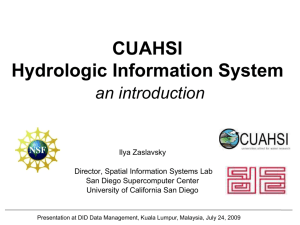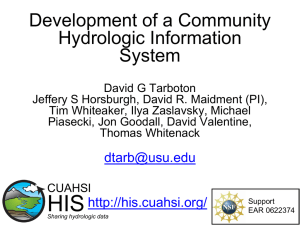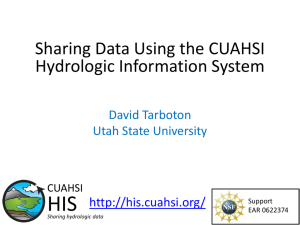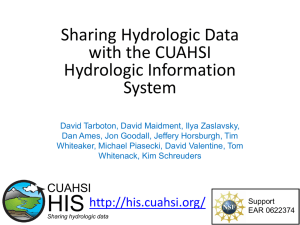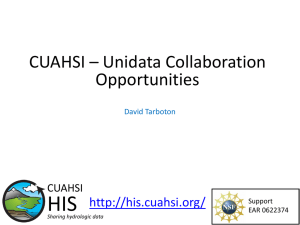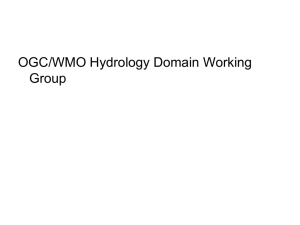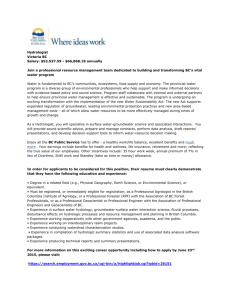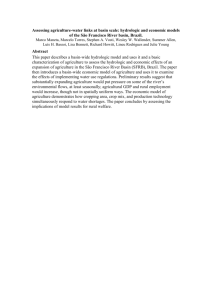geoinfo_abstr2
advertisement
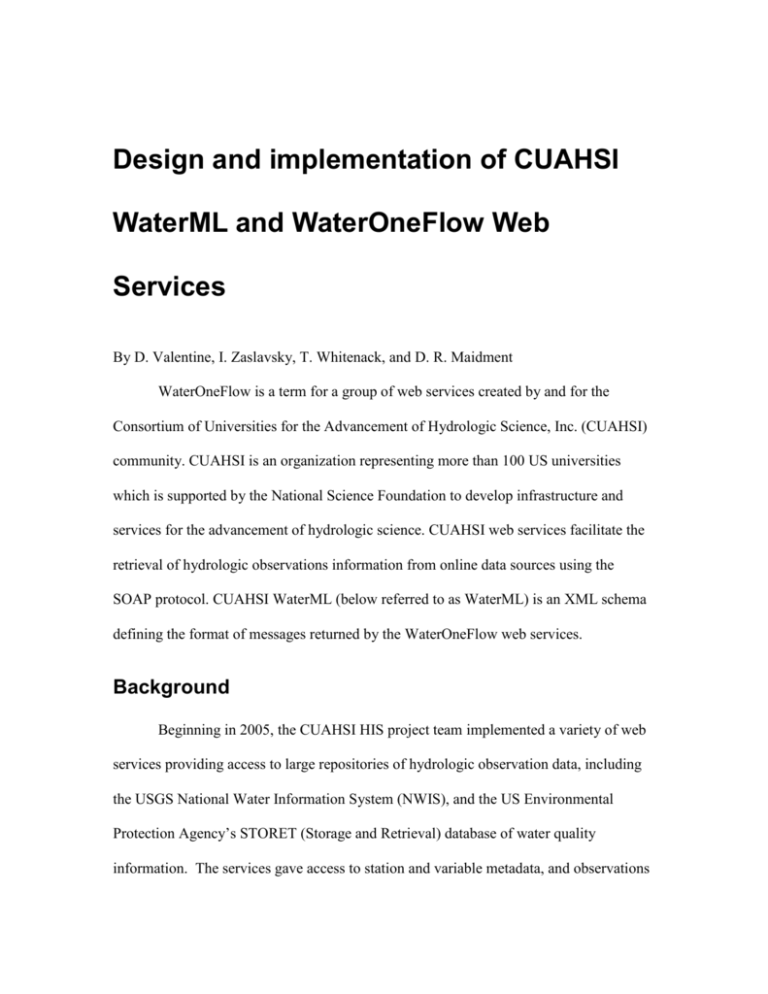
Design and implementation of CUAHSI
WaterML and WaterOneFlow Web
Services
By D. Valentine, I. Zaslavsky, T. Whitenack, and D. R. Maidment
WaterOneFlow is a term for a group of web services created by and for the
Consortium of Universities for the Advancement of Hydrologic Science, Inc. (CUAHSI)
community. CUAHSI is an organization representing more than 100 US universities
which is supported by the National Science Foundation to develop infrastructure and
services for the advancement of hydrologic science. CUAHSI web services facilitate the
retrieval of hydrologic observations information from online data sources using the
SOAP protocol. CUAHSI WaterML (below referred to as WaterML) is an XML schema
defining the format of messages returned by the WaterOneFlow web services.
Background
Beginning in 2005, the CUAHSI HIS project team implemented a variety of web
services providing access to large repositories of hydrologic observation data, including
the USGS National Water Information System (NWIS), and the US Environmental
Protection Agency’s STORET (Storage and Retrieval) database of water quality
information. The services gave access to station and variable metadata, and observations
data stored at these sites. As the services were written for each data source individually,
their inputs and outputs were different across data sources. The services developed in
this ad hoc manner do not scale well. As the number and heterogeneity of data streams to
be integrated in CUAHSI’s hydrologic data access system increased, it would become
more and more difficult to develop and maintain a growing set of client applications
programmed against the different signatures and keep track of data and metadata
semantics of different sources. As a result, WaterML was developed to provide a
systematic way to access water information from point observation sites.
Point Observations Information Model
In parallel with web service development, CUAHSI has been developing an
information model for hydrologic observations that is called the Observations Data
Model (ODM). Its purpose is to represent observation data in a generic structure that
accommodates different source schemas. While based on the preliminary set of CUAHSI
web services, WaterML was further refined through standardization of terminology
between WaterML and ODM, and through analysis of access syntax used by different
observation data repositories, including USGS NWIS, EPA STORET, NCDC ASOS,
Daymet, MODIS, and NAM12K
FIGURE 1 NEAR HERE
According to the information model, a Data Source operates one or more
observation networks; a Network is a set of observation sites; a Site is a point location
where water measurements are made; a Variable describes one of the types of
measurements; and a time series of Values contains the measured data, wherein each
value is characterized by its time of measurement and possibly by a qualifier which
supplies additional information about the observation. Figure 1 demonstrates the main
components of the model, and respective web services.
WaterML concepts
The goal of the first version of WaterML was to encode the semantics of
hydrologic observations discovery and retrieval and implement WaterOneFlow services
in a way that creates the least barriers for adoption by the hydrologic research
community. In particular, this implied maintaining a single common representation for
the key constructs returned on web service calls, related to observations, features of
interest, observation procedures, observation series, etc.
An observation is considered an act of assigning a number, term or other symbol
to a phenomenon, and a result of such assignment. Hydrologic observations are
performed against many different phenomena (properties of different features of
interest), and shall be associated with time measurements (time points or time intervals).
The features of interest common in hydrologic observations may include points (gauging
stations, test sites), linear features (steams, river channels), or polygon features
(catchments, watersheds). Spatial properties of the features of interest may be further
expressed in 2D or 3D, in particular via vertical offsets against common reference
features. The observations are made in a particular medium (water, air, sediments) using a
procedure. The procedure may represent a multi-step processing chain including an
instrument (sensor), algorithms for transforming the initially measured property (e.g.
“partial pressure of oxygen in the water” may be transformed into a measure of
“dissolved oxygen concentration”), and various techniques for censoring and quality-
controlling of the value assignment, including multiple scenarios for assignment of no
value. Individual observations are organized into observation series (regular sequences of
observations of a specific variable made at a specific site), which are in turn referenced in
series catalogs. A series catalog is an element of an observation network, which
represents a collection of sites where a particular set of variables is measured. A
responsible organization can maintain one or more observation networks.
In addition to point measurements described in the ODM specification,
hydrologic information may be available as observations or model outcomes aggregated
over user-defined regions or grid cells. While USGS NWIS and EPA STORET exemplify
the former case, sources such as MODIS and Daymet are examples of the latter. In this
latter case, as in the case of other remote sensing products or model-generated grids, the
observation or model-generated data are treated as coverages, and sources of such data
are referenced in WaterML as datasets, as opposed to sites.
The practice of hydrologic observations provides ample evidence of
complications beyond this general treatment. These complications are related to huge,
complex and incompatible vocabularies used by several federal hydrologic observation
systems, to different and not always documented contexts of measurement and value
assignment, to often ambiguously defined features of interest, to complex organizational
contexts of hydrologic measurement, transformation and aggregation, etc. It is in
response to this complexity that the CUAHSI WaterML is primarily designed. While
some of this complexity may be captured within the standards being developed under the
OGC’s Sensor Web Enablement (SWE) activity, the flexibility inherent in such standards
may itself be a barrier to adoption when the target audience is not computer scientists.
Implementation Context
WaterML is primarily designed for relaying fundamental hydrologic time series
data and metadata between clients and servers, and to be generic across different data
providers. Different implementations of WaterOneFlow services may add supplemental
information to the content of messages. However, regardless of whether or not a given
WaterML document includes supplemental information, the client shall be sure that the
portion of WaterML pertaining to space, time, and variables will be consistent across any
data source.
Depending on the type of information that the client requested, a WaterOneFlow
web service will assemble the appropriate XML elements into a WaterML response, and
deliver that to the client. The core WaterOneFlow methods include:
GetSiteInfo – for requesting information about an observations site. The returned
document has a root element of SiteInfoResponse type.
GetVariableInfo – for requesting information about a variable. The returned
document has a root element of VariableResponse type.
GetValues – for requesting a time series for a variable at a given site or spatial
fragment of a dataset. The returned document has a root element of
TimeSeriesResponse type.
The provisional services are available from http://water.sdsc.edu. The CUAHSI
WaterML description has been submitted as a discussion paper to the Open Geospatial
Consortium, and is available from the OGC portal. The project web site is
http://www.cuahsi.org/his .
Figure 1. CUAHSI Point Observations Information Model, and corresponding
web service methods.
USGS
Data Source
Source
S
Streamflow
gages
w
s
k
Neuse River near Clayton, NC
NC
Return network information, and variable
information within the network
Network
Sites
Return site information, with a series
catalog of variables measured at a site
and their period of measurment
s Observation
Discharge, stage, start, end
Series
(Daily or instantaneous)
Return time series
n
end
of values
Values
s
instantaneous)
206 cfs, 13 August 2006 {Value, Time, Qualifier}
s
6
s 2006
Qualifier}

